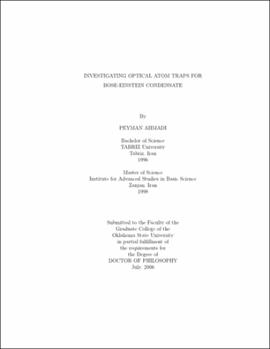| dc.contributor.advisor | Summy, Gil S. | |
| dc.contributor.author | Ahmadi, Peyman | |
| dc.date.accessioned | 2013-11-26T08:26:27Z | |
| dc.date.available | 2013-11-26T08:26:27Z | |
| dc.date.issued | 2006-07 | |
| dc.identifier.uri | https://hdl.handle.net/11244/6871 | |
| dc.description.abstract | Scope and Method of Study: The purpose of this research was to make a Bose Einstein condensate (BEC) of Rb87 atoms using an all optical method. Specific attention was given to replacing the traditional magnetic traps with dipole traps created by high power, far off resonant CO2 laser beams (FORT) for trapping and evaporative cooling. | |
| dc.description.abstract | Findings and Conclusions. Three major steps where identified necessary to realize a BEC: (a)preparing a source of cold atoms (magneto optical trap (MOT)), b) loading atoms from the MOT to the FORT, (c)evaporative cooling the atoms in the FORT to nanoKelvin temperatures. Successful accomplishment of these steps lead us to create BEC. While investigating step (b), we found that the power in the CO2 laser does not affect the FORT population after a certain power is achieved. Also a strong correlation between the CO2 beam waist and the loading efficiency was observed. These findings led us to employ the concept of a time averaged potential to increase the trap's population. The basic idea was to sweep a tightly focused CO2 beam while it was overlapped with the MOT. By sweeping the CO2 beam rapidly, atoms could not react to the beam movement and therefore felt a time-averaged potential. These ideas were supported with the observation of lower temperatures for the trapped atoms in the time-averaged FORTs compared to the atoms trapped in the stationary FORT. By adiabatically damping the sweeping amplitude most of the atoms could be forced to accumulate into a non-time averaged trap with a tight waist. Using this technique a 100% increase in the loading efficiency of the FORT was observed. | |
| dc.description.abstract | Our numerical simulations showed that spherical aberration creates local intensity maxima along the CO2 beam propagation direction which are capable of trapping atoms. This prediction was confirmed by the experimental observation of well separated micro-optical traps. We found that the separation of the micro-optical traps could be changed making them a suitable system for the study of quantum computation with neutral atoms. | |
| dc.format | application/pdf | |
| dc.language | en_US | |
| dc.rights | Copyright is held by the author who has granted the Oklahoma State University Library the non-exclusive right to share this material in its institutional repository. Contact Digital Library Services at lib-dls@okstate.edu or 405-744-9161 for the permission policy on the use, reproduction or distribution of this material. | |
| dc.title | Investigating optical atom traps for Bose-Einstein condensate | |
| dc.contributor.committeeMember | Wilson, Timothy M. | |
| dc.contributor.committeeMember | Westhaus, Paul A. | |
| dc.contributor.committeeMember | Rosenberger, Albert T. | |
| dc.contributor.committeeMember | Abraham, Eric | |
| dc.contributor.committeeMember | Materer, Nicholas F. | |
| osu.filename | Ahmadi_okstate_0664D_1930.pdf | |
| osu.accesstype | Open Access | |
| dc.type.genre | Dissertation | |
| dc.type.material | Text | |
| thesis.degree.discipline | Physics | |
| thesis.degree.grantor | Oklahoma State University | |
